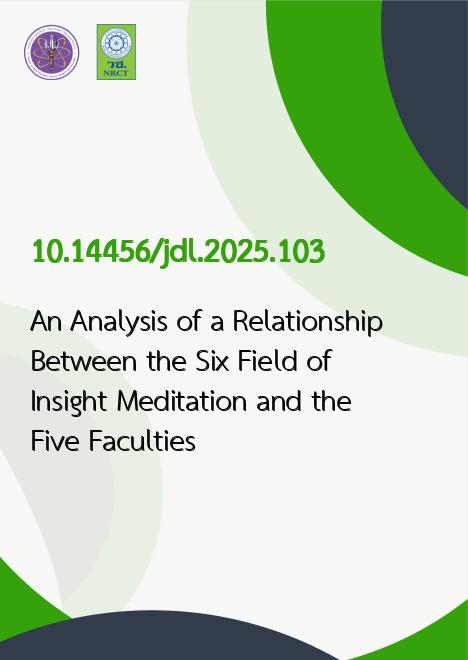
|
An Analysis of a Relationship Between the Six Field of Insight Meditation and the Five Faculties |
|---|---|
| รหัสดีโอไอ | |
| Creator | Anutchai Loungamornchai |
| Title | An Analysis of a Relationship Between the Six Field of Insight Meditation and the Five Faculties |
| Publisher | Buddhist Studies Foundation Wat Buranasiri Matayaram |
| Publication Year | 2568 |
| Journal Title | Journal of Dhamma for Life |
| Journal Vol. | 31 |
| Journal No. | 1 |
| Page no. | 729-738 |
| Keyword | Analysis, Relationship, Six Field of Insight Meditation, Five Faculties |
| URL Website | https://so08.tci-thaijo.org/index.php/dhammalife |
| Website title | https://so08.tci-thaijo.org/index.php/dhammalife/article/view/4715 |
| ISSN | 2822-048X |
| Abstract | The objectives of this research are: (1) to study the Vipassana meditation in Theravada Buddhist scriptures; (2) to study Vipassana meditation and faculty adjustment as it appears in Theravada Buddhist scriptures; (3) to analyze the relationship between Vipassana meditation and adjusting the faculties for Vipassana practice. The research method was descriptive document work.The results revealed that meditation is a practical principle of development of human beings, focusing on training the mind for right views for gaining the wisdom and understand the reality of things as it was which leads to be free from suffering according to the teachings of Buddhism. The final goal of Samatha practicing is Jhāna attainment, which is a by-product that occurs, namely 4 Rūpajhāna, 4 Arupajhāna, 8 Samādhi and 6 Abhiññā, and the cultivation of Vipassanā meditation to gain the wisdom seeing the arising and passing away of forms and names as they really were according to the principles of the Three Common Characteristics. Until attaining the Dhamma of becoming an Anāgāmī or Arahantaship who completely abandoned all defilements according to the sequence of enlightenment at each level until the highest point or Nibbana. All defilements can be completely cut off, leaving no remains.Vipassanābhūmi refers to the base where one does contemplate on as the objects of Vipassanāmeditation. Vipassana practice requires contemplated objects. The state experienced as an object of Vipassana must be existing and does not change from its own state called ultimate state of Dhamma which is used as the base of practice consisting of 5 types: 5 Khandha, 12 Āyatana, 14 Dhātu, 22 Indriya, 4 Noble Truth, and 12 Paṭiccasamuppāda, in brief they are only form and name related to Vipassana practice. For Satipatthana practice one must be a process of adjusting the balance of 5 faculties: (1) Saddhindriya is against disbelief, (2) Viriyindriya has the power to eliminate laziness, (3) Satindriya has the power to eliminate heedlessness, (4) Samādhindriya has the power to eliminate distraction, (5) Paññindriya has the power to eliminate delusion.Analyzing the relationship between insight’s planes and adjusting the sensual organs was found that adjusting the faculties to balance means adjusting the infaculties to be equal in pairs: 1) adjusting faith to be equal to wisdom, 2) adjusting wisdom to be equalto faith, 3) adjusting perseverance to equal to concentration, 4) adjusting concentration to be equal to persistence, 5) the more mindfulness the better, not lacking, not more than and it supports other faculties for balance faster. Adjusting the Indriya related to the five Vipassanābhūmi, namely the five Khandha, 12 Āyatanas, etc., as its concentrative objects for experiencing Three Characteristics. Balancing the 5 Indriya will make practice progress and leading to the final goal, Arahantship quickly, accordingly the Arahanta is called the one who completed faculties balance training. |